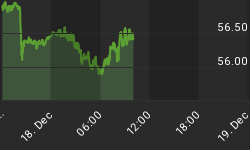What are the Fed's "gears"? Its policy goal of keeping long rates low by raising short rates to control inflation expectations.
What's the "monkey wrench"? Big sellers, probably of Asian origin, are selling into this apparent strength.
The evidence? This Reuters article.
Reuters reports that supposedly "benign" September inflation numbers (of "only" 0.1 percent at the core level, but a whopping 1.2 percent overall) initially helped treasuries and pushed them higher, when sellers suddenly showed up, driving treasuries lower and thereby yields up.
What's a Fed official to do?
That's easy: Trot out president Bush's White House Speaker, Scott McLellan, to calm people's fears that inflation may be getting out of hand by affirming his "confidence" that the Fed will be able to "tackle inflation."
Pretty weak ammunition, if you ask me. A mere PR stunt to try and control the fallout from decades of over-borrowing and over-spending at the federal level.
Can it work?
Sometimes you can simply break a cog in the wheels by applying a little more force than usual and, once the obstruction is gone, the gears will run smoothly again. But when the wrench is bigger than the gears, you may be facing a problem.
What could possibly be "bigger" than the central bank behind the world's most powerful economy in the richest country in human history, you ask?
How about its number one and number two creditors - Japan and China - knocking at the door, looking for payment? Or, worse yet, telling the US they have dropped its revolving credit line and won't lend any more?
How about people not really caring about what the government calls "core" inflation. People know they can't exist for long without food and fuel, so what's the point of pretending these two necessities have no real relevance to nationwide price increases?
That this is so is made abundantly clear by the powerful and solid way in which gold is moving up. Even the financial press now notes that gold is now largely and increasingly immune to a rising dollar. Gold keeps punches through one important price level after another and immediately consolidates at the higher level without breaking down, paving the way for further price increases.
But how does that explain a falling gold price while the dollar is dropping, as it did today, on Friday, October 14, 2005?
It's one thing if gold rises while the dollar rises because people are scared of paper currencies and so they hang on to their gold even while the dollar keeps banging its head against the 90 Point Iron Ceiling, but that's a far cry from saying that gold is now moving in lock-step with the dollar.
Here is an updated version of the same chart:

As expected, the dollar ran its head right back up into that ceiling since Septmber, but it hasn't convincingly broken through the 90-point level on the US Dollar Index since it dropped below that mark in November of 2003!
Gold, on the other hand, has been rising ever since September, all but ignoring the dollar's desperate trampoline act.

If people are buying gold because they are scared of fiat currencies' instability, then proof of that instability can hardly be the reason for them to sell gold.
If even the press admits that gold is rising because of inflation fears, then how can gold fall on a day when the Bureau of Labor Statistics reports that the September CPI rose by more than a full percentage point in one month alone, putting the annualized rate at 9.4 percent, the highest it's been since 1980??
No. Gold fell for entirely different reasons - and none of them fall under the category of ordinary market forces. Gold was pushed down to make it appear as if people were focusing more on the "benign" core-inflation numbers than on the real price increases.
Gold was pushed down to make things look as if investors were "relieved" and felt sufficiently reassured to unload some of their gold investments. The policy goal? Calm inflation fears, of course.
A band aid applied to patch up a severed limb, just like Scott McLelland's statement above.
Whom are they trying to fool?
When the monkey wrench gets bigger than the gears, the same old bag of tricks just don't work that well anymore.
Got gold?















